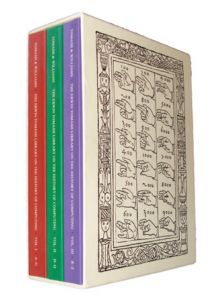Publisher Information: 2009.
The Most Comprehensive Reference Work on the Historical Literature of Computing
Tomash, Erwin & Michael R. Williams. The Erwin Tomash library on the history of computing. An annotated and illustrated catalog. 3 vols. 1572 pages, with approximately 4000 illustrations. Privately printed, 2009. 277 x 214 mm. Soft covers, in slipcase.
This extensively annotated catalogue with approximately 4000 illustrations describes the library formed by computing pioneer Erwin Tomash of over 3000 books and manuscripts on the history of mathematics and computation issued between 1180 and 1955. It is the most comprehensive reference work ever published on the historical literature of computing from its beginnings to the early years of electronic computers.
In his introduction, Tomash writes: "The collection as a whole documents the roots of the history of computing. Included in its scope are books on all forms of reckoning, including finger reckoning, and on other aids to calculation such as the slide rule and the abacus. . . . I included early aids to measurement (instruments), not to mention the very basis of calculation (arithmetic), planetary calculations (astronomy), volumetric computation (gauging), calendric calculation (computus), land measurement (surveying), position reckoning (navigation), calculations associated with erecting sundials (dialing), and, of course, the slide rule, the sector, and mathematical tables. In this admittedly broad view, the modern computer is the natural outgrowth of the continuing search for better, more accurate 'scientific instruments' and of an associated need for 'aids to calculation' to analyze the date arising from measurements made with these instruments."
Erwin Tomash was born in St. Paul, Minnesota, and grew up in that state. In 1943 he graduated from the University of Minnesota with a degree in electrical engineering. He then went into the U.S. Army Signal Corps, where he worked with radar and was awarded the Bronze Star for his wartime activities. After being demobilized from the war, Tomash spent a brief time with the Naval Ordnance Laboratory and then joined Engineering Research Associates. There he worked on developing electronic computers, including the ERA 1103 or UNIVAC Scientific. In 1956 Tomash joined Telemeter Magnetics, a Los Angeles-based company. Soon he became the company's president, and oversaw Telemeter Magnetics' design of core memories for computers. In 1962 he left Telemeter Magnetic, which had been bought by Ampex, and co-founded a new company, Dataproducts Corporation. Dataproducts specialized in computer technology, especially printers, and by 1970 had become the world's leading independent printer manufacturer. With his wife, Adele, he founded the Charles Babbage Institute for the History of Information Technology at the University of Minnesota.
Michael R. Williams graduated in 1964 with a BSc in Chemistry from the University of Alberta and in 1968 he obtained a PhD in Computer Science from the University of Glasgow. In 1969 he joined the University of Calgary, first in the Department of Mathematics then as a Professor of Computer Science. It was while working at Glasgow that he acquired an interest in the history of computing, something which has developed over the years into his main research and teaching interest. He has participated in the publishing of 11 books, 88 articles, 58 technical reviews, delivered 72 invited lectures in several different subject areas and has been involved in the creation of 9 different radio, television, and museum productions. During his career he has had the opportunity to work for extended periods at several different universities and at the National Museum of American History (Smithsonian Institution) and as Head Curator at the Computer History Museum in Mountain View, California. Besides his work as editor-in-chief for the journal Annals of the History of Computing, he is a member of editorial boards concerned with publishing material in the area of the history of computing, and has worked closely with the IEEE History Committee (serving as its chairman in 1994 and 1995), and the IEEE History Center. His involvement with IEEE Computer Society publishing eventually led him to become editor-in-chief of the Computer Society Press, vice-president for publications, and in 2007 president of the IEEE Computer Society.
In Collection
#4678
Read It:
Yes
#4678
Read It:
Yes
|
|
||||||||
